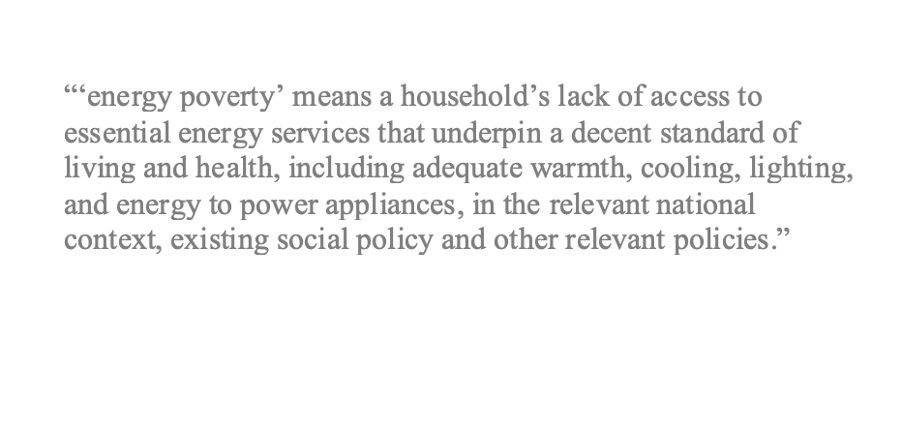It’s out - the Energy Performance of Buildings Directive recast. We’ve all been waiting with bated breath for the central measure - Minimum #EnergyPerformance Standards - to kick-start the ‘Renovation Wave’.
Can we expect a deluge or a dribble? THREAD 1/11
#EPBD
Can we expect a deluge or a dribble? THREAD 1/11
#EPBD

MEPS are essential to increase stubbornly low renovation rate AND one of few measures that can direct renovations to worst-performing buildings, alleviating #energypoverty
MEPS start with worst performing but should not stop there. They set a plan to fully decarbonise by 2050
MEPS start with worst performing but should not stop there. They set a plan to fully decarbonise by 2050
The MEPS has 2 parts. 2nd is important but may get lost. Requires MSs to set timelines for MEPS for all bldgs to meet higher energy perf. class by 2040 & 2050
Potentially powerful plan for whole stock! Key to an effective framework, esp. given the weakness of 1st part… 3/11
Potentially powerful plan for whole stock! Key to an effective framework, esp. given the weakness of 1st part… 3/11

1st part sets min ambition by 2030/33:
✔️All sectors, buildings in EPC classes ‘F’ & ‘G’ (but see 9/11)
✖️ Improve buildings by one EPC band (eg to G to F or F or E)
➖ Trigger dates:
Non-resi: must be F by 2027, and to E by 2030
Residential: must be F by 2030, E by 2033
4/11
✔️All sectors, buildings in EPC classes ‘F’ & ‘G’ (but see 9/11)
✖️ Improve buildings by one EPC band (eg to G to F or F or E)
➖ Trigger dates:
Non-resi: must be F by 2027, and to E by 2030
Residential: must be F by 2030, E by 2033
4/11

The big mistake? The ambition for the renovation triggered is low – default is 1 or 2 EPC class.
Each renovation should be deep or start a deep staged renovation. Deep & staged reno standards are most effective to deliver EU goals. 5/11
tinyurl.com/2p8ehw53 #GreenDeal
Each renovation should be deep or start a deep staged renovation. Deep & staged reno standards are most effective to deliver EU goals. 5/11
tinyurl.com/2p8ehw53 #GreenDeal

Without an ambitious standard in EPBD, G/F class buildings will meet only EPC F/E by 2030.
F or E class buildings are:
- Not fully renovated (perf. bands below)
- Not climate aligned or future proof
- Do not protect households from #energypoverty or gas price crisis
6/11
F or E class buildings are:
- Not fully renovated (perf. bands below)
- Not climate aligned or future proof
- Do not protect households from #energypoverty or gas price crisis
6/11

Similar standard in UK led to some commercial buildings only needing a lighting retrofit to comply. A wasted opportunity. tinyurl.com/bdejbxm7
Gov now committed to much higher EPC B by 2030, but bldg owners didn't have opportunity to renovate once in full knowledge. 7/11
Gov now committed to much higher EPC B by 2030, but bldg owners didn't have opportunity to renovate once in full knowledge. 7/11
Compare EPBD’s ambition to:
- the Scottish government: will require all owner-occupied homes to be EPC C by 2033 – the same year that the EPBD asks homes to be just EPC E!
- the Dutch government: requires all offices to be EPC C by 2023! 8/11
tinyurl.com/3jrwrmfa
- the Scottish government: will require all owner-occupied homes to be EPC C by 2033 – the same year that the EPBD asks homes to be just EPC E!
- the Dutch government: requires all offices to be EPC C by 2023! 8/11
tinyurl.com/3jrwrmfa
More risk to ambition is the % of buildings targeted as ‘F&G’. This is entirely reliant on proposed changes to EPCs in separate article.
Aim is to harmonise EPC scales to A-G, and redistribute stock with 15% in G. Currently, F&G defines very different %. 9/11
Aim is to harmonise EPC scales to A-G, and redistribute stock with 15% in G. Currently, F&G defines very different %. 9/11

Regulations alone don’t ensure successful renovations. We need practical & financial support – esp. for low-income & #energypoor households.
Additional funds are missing. The quoted 144bn from the social climate fund & 61bn from RRPs are not designated to help meet MEPS. 10/11
Additional funds are missing. The quoted 144bn from the social climate fund & 61bn from RRPs are not designated to help meet MEPS. 10/11
Critical to MEPS:
- One-stop shops, skilled and resourced to support vulnerable households
- EU reno fund targeted to low-income households
- Technical assistance to MSs/regions
- Protections for tenants' housing affordability
11/11
See @RightToEnergy: tinyurl.com/sw737bja
- One-stop shops, skilled and resourced to support vulnerable households
- EU reno fund targeted to low-income households
- Technical assistance to MSs/regions
- Protections for tenants' housing affordability
11/11
See @RightToEnergy: tinyurl.com/sw737bja

• • •
Missing some Tweet in this thread? You can try to
force a refresh













